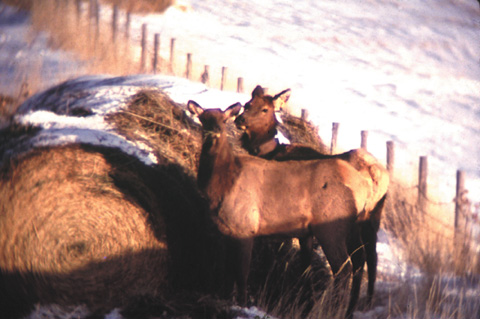| |
|
|

from the issue of March 4, 2004
|

| |
|
|
| |
Elk tracked to determine best herd size

BY STEVE RESS, SCHOOL OF NATURAL RESOURCES
The optimal number of elk in northwestern Nebraska’s Pine Ridge area is probably about 600, UNL research shows.

| | 
 
| | | Elk eat from hay bales on Pine Ridge property in western Nebraska. Elk that eat livestock feed and damage private property are a concern to local landowners. UNL research is trying to determine the ideal herd size of elk that the area could sustain and be acceptable to the public. Photo courtesy of School of Natural Resources.

|
Scott Hygnstrom, wildlife damage specialist, and Jim Merchant, a geographic information systems specialist, coordinated this School of Natural Resources research. The team monitored habitat use, movements and population dynamics of Nebraska’s elk herds for eight years to better understand how to manage these native but seldom-seen animals.

The current elk population in the Pine Ridge includes about 200 animals, equally divided between the Bordeaux area near Chadron and the Hat Creek area near Crawford.

“The optimal number is somewhat elusive,” Hygnstrom said of the Pine Ridge elk. “The habitat in the region could probably sustain up to 2,000 animals. However, the damage they do to crops, such as hay bales and winter wheat, and to fences indicates that only a smaller number would be acceptable to the public.”

Researchers tracked 21 female elk with radio transmitters attached to neck collars. Findings provide important insights about the kinds of habitat elk favor for wintering and calving, their forest preferences, use of streamside habitat and the effects of human activities such as traffic, timber harvesting, farming and ranching on elk distribution.

“We were able to learn a great deal about their population dynamics, movements and habitat selection, in addition to being able to examine them for indications of diseases and general herd health,” the Institute of Agriculture and Natural Resources wildlife specialist said.

This was the first study of its kind in Nebraska. Findings indicated the herds are relatively disease-free and generally tend to avoid association with cattle or deer.

Elk are native to Nebraska but had disappeared from the state by the end of the 19th century. They began recolonizing the Pine Ridge region from the Lusk Hills of Wyoming and possibly the Black Hills of South Dakota during the 1960s.

“By the late 1980s, they were thriving to the point that they required management,” Hygnstrom said. “As the herd grew, it became a balancing act between the needs and desires of hunters, landowners and the public.”

Researchers set out to determine overall ecological factors that would improve management of elk populations. Surveys in association with the research indicated that 55 percent of area landowners favored free-ranging elk in the Pine Ridge, but they also were concerned about elk damage to crops and property. Ninety-two percent of tourists surveyed supported free-ranging elk and said they would pay to view them.

“Nebraska is unique in that most of the elk here exist on privately owned land, whereas in states such as Colorado and New Mexico, most of the elk herds inhabit public lands. The situation here creates some tension between the elk and private landowners,” Hygnstrom said. “It’s not that we have too many elk but that the elk spend too much time in the wrong areas.”

The team is developing research-based management recommendations for the Nebraska Game and Parks Commission, including how the two herds can be dispersed from privately to publicly owned land. Hunting is one way to trim the population. Nebraska currently issues about 50 elk permits annually, and about half those hunters bag an elk.

Hygnstrom wants to continue this work by resurveying the herds and studying mating patterns and possible genetic effects of inbreeding in the small herds.

The Nebraska Game and Parks Commission, Rocky Mountain Elk Foundation, U.S. Forest Service and Nebraska Bowhunter’s Association funded this research, with cooperation from Pine Ridge landowners.
GO TO: ISSUE OF MARCH 4
NEWS HEADLINES FOR MARCH 4
3 UNL professors win NU honors
Elk tracked to determine best herd size
New lights improve exit signs
Chancellor answers questions about Gallup survey
Identity theft is no laughing matter
Marketing students join GM to create agency
Survey builds rapport
731644S32962X
|
|
|
|
|
|
|
|